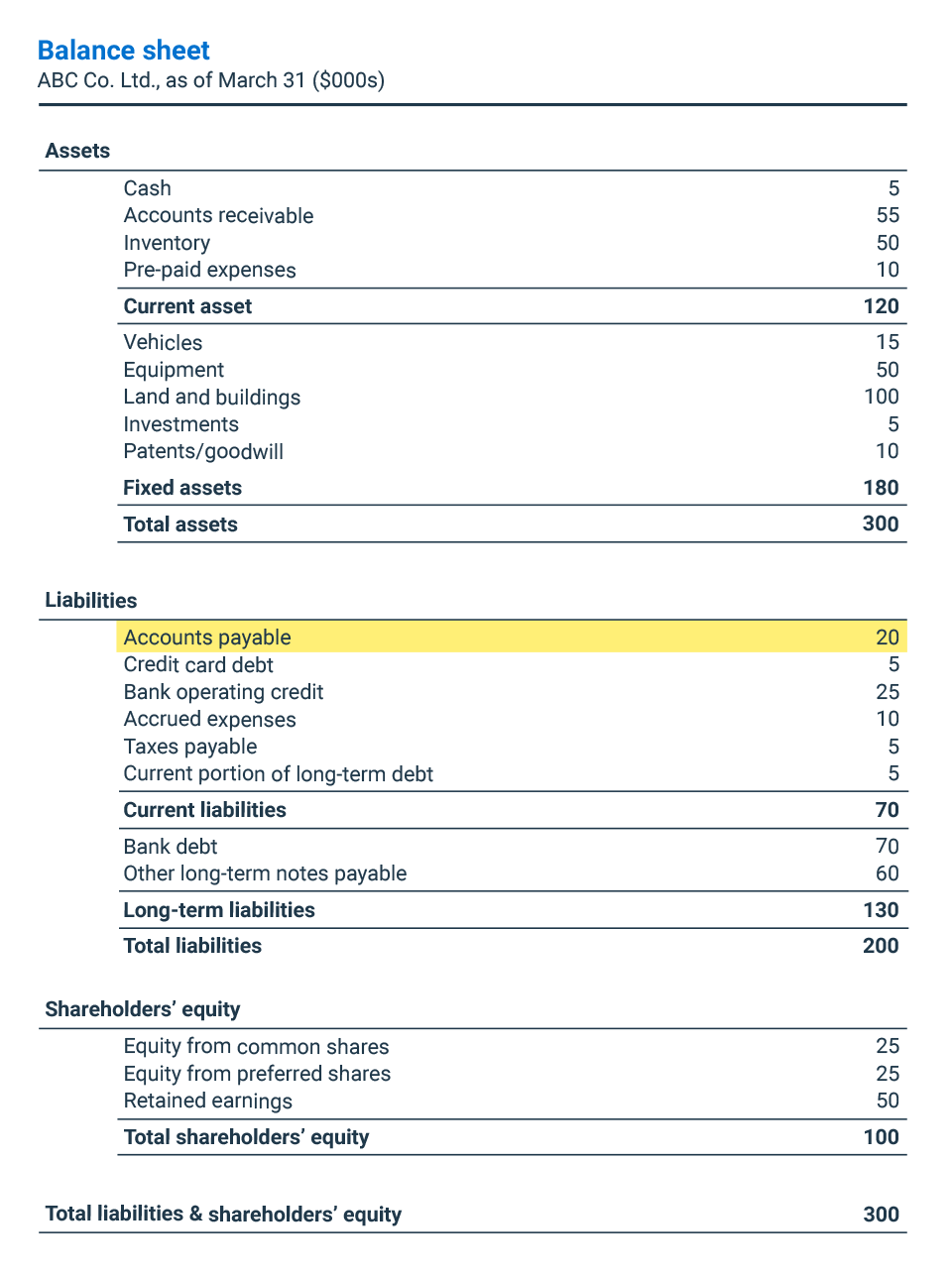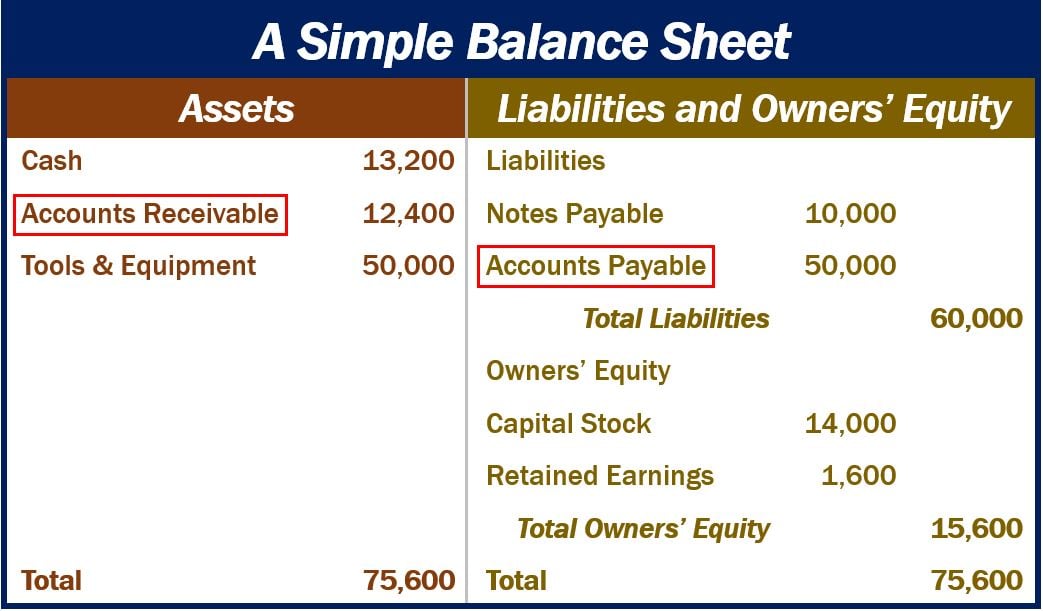Is Accounts Payable On The Balance Sheet - Accounts payable is a current liability on a company's balance sheet that represents the unpaid bills owed to suppliers and vendors for products or services paid for on. Accounts payable is listed on a company's balance sheet. Accounts payable is a liability since it is money owed to creditors and is listed under current liabilities on the balance. Ap is considered one of the most current forms of the current liabilities on. Do accounts payable appear on a balance sheet? Accounts payable is expected to be paid off within a year’s time or within one operating cycle (whichever is shorter). Accounts payable appears on the balance sheet, a fundamental financial statement that provides a snapshot of a company’s financial position at a specific point in time. Accounts payable should absolutely appear on a balance sheet as it represents outstanding payments owed by your business, and it’s one.
Accounts payable is a current liability on a company's balance sheet that represents the unpaid bills owed to suppliers and vendors for products or services paid for on. Accounts payable should absolutely appear on a balance sheet as it represents outstanding payments owed by your business, and it’s one. Accounts payable is listed on a company's balance sheet. Accounts payable is a liability since it is money owed to creditors and is listed under current liabilities on the balance. Accounts payable is expected to be paid off within a year’s time or within one operating cycle (whichever is shorter). Ap is considered one of the most current forms of the current liabilities on. Do accounts payable appear on a balance sheet? Accounts payable appears on the balance sheet, a fundamental financial statement that provides a snapshot of a company’s financial position at a specific point in time.
Accounts payable is a liability since it is money owed to creditors and is listed under current liabilities on the balance. Do accounts payable appear on a balance sheet? Accounts payable is a current liability on a company's balance sheet that represents the unpaid bills owed to suppliers and vendors for products or services paid for on. Accounts payable should absolutely appear on a balance sheet as it represents outstanding payments owed by your business, and it’s one. Accounts payable is listed on a company's balance sheet. Accounts payable appears on the balance sheet, a fundamental financial statement that provides a snapshot of a company’s financial position at a specific point in time. Accounts payable is expected to be paid off within a year’s time or within one operating cycle (whichever is shorter). Ap is considered one of the most current forms of the current liabilities on.
Is accounts payable always a credit? Leia aqui Is accounts payable
Accounts payable is listed on a company's balance sheet. Accounts payable should absolutely appear on a balance sheet as it represents outstanding payments owed by your business, and it’s one. Accounts payable is a liability since it is money owed to creditors and is listed under current liabilities on the balance. Do accounts payable appear on a balance sheet? Accounts.
Taxes Payable on Balance Sheet Owing Taxes — 1099 Cafe
Accounts payable appears on the balance sheet, a fundamental financial statement that provides a snapshot of a company’s financial position at a specific point in time. Accounts payable is a liability since it is money owed to creditors and is listed under current liabilities on the balance. Accounts payable is listed on a company's balance sheet. Accounts payable is expected.
Liabilities Side of Balance Sheet
Accounts payable is a current liability on a company's balance sheet that represents the unpaid bills owed to suppliers and vendors for products or services paid for on. Ap is considered one of the most current forms of the current liabilities on. Accounts payable appears on the balance sheet, a fundamental financial statement that provides a snapshot of a company’s.
The Balance Sheet
Accounts payable should absolutely appear on a balance sheet as it represents outstanding payments owed by your business, and it’s one. Accounts payable appears on the balance sheet, a fundamental financial statement that provides a snapshot of a company’s financial position at a specific point in time. Accounts payable is listed on a company's balance sheet. Ap is considered one.
How Do Accounts Payable Show on the Balance Sheet?
Do accounts payable appear on a balance sheet? Accounts payable should absolutely appear on a balance sheet as it represents outstanding payments owed by your business, and it’s one. Accounts payable is expected to be paid off within a year’s time or within one operating cycle (whichever is shorter). Accounts payable appears on the balance sheet, a fundamental financial statement.
What are accounts payable? BDC.ca
Accounts payable appears on the balance sheet, a fundamental financial statement that provides a snapshot of a company’s financial position at a specific point in time. Accounts payable is expected to be paid off within a year’s time or within one operating cycle (whichever is shorter). Accounts payable is a liability since it is money owed to creditors and is.
What Are Trade Payables? (Examples Included)
Accounts payable is a liability since it is money owed to creditors and is listed under current liabilities on the balance. Accounts payable is expected to be paid off within a year’s time or within one operating cycle (whichever is shorter). Accounts payable is a current liability on a company's balance sheet that represents the unpaid bills owed to suppliers.
What is accounts receivable? Definition and examples
Accounts payable is listed on a company's balance sheet. Accounts payable is expected to be paid off within a year’s time or within one operating cycle (whichever is shorter). Accounts payable should absolutely appear on a balance sheet as it represents outstanding payments owed by your business, and it’s one. Accounts payable appears on the balance sheet, a fundamental financial.
What are Accounts Receivable and Accounts Payable?
Ap is considered one of the most current forms of the current liabilities on. Accounts payable appears on the balance sheet, a fundamental financial statement that provides a snapshot of a company’s financial position at a specific point in time. Accounts payable is expected to be paid off within a year’s time or within one operating cycle (whichever is shorter)..
Bills Payable in Balance Sheet Double Entry Bookkeeping
Ap is considered one of the most current forms of the current liabilities on. Accounts payable is expected to be paid off within a year’s time or within one operating cycle (whichever is shorter). Do accounts payable appear on a balance sheet? Accounts payable is a current liability on a company's balance sheet that represents the unpaid bills owed to.
Accounts Payable Is A Liability Since It Is Money Owed To Creditors And Is Listed Under Current Liabilities On The Balance.
Accounts payable is a current liability on a company's balance sheet that represents the unpaid bills owed to suppliers and vendors for products or services paid for on. Ap is considered one of the most current forms of the current liabilities on. Accounts payable appears on the balance sheet, a fundamental financial statement that provides a snapshot of a company’s financial position at a specific point in time. Accounts payable should absolutely appear on a balance sheet as it represents outstanding payments owed by your business, and it’s one.
Accounts Payable Is Listed On A Company's Balance Sheet.
Do accounts payable appear on a balance sheet? Accounts payable is expected to be paid off within a year’s time or within one operating cycle (whichever is shorter).








